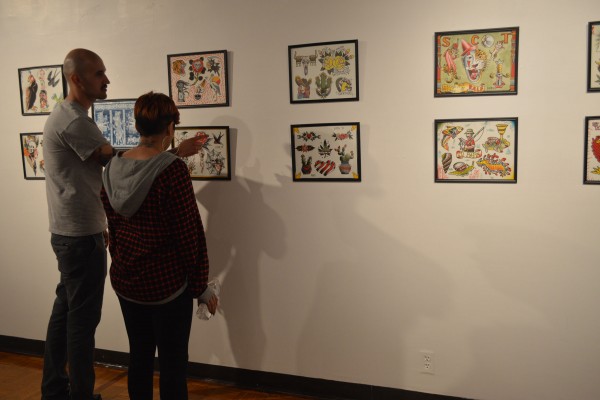In recent years, tattoos have transitioned from taboo to mainstream and are now being embraced by the art world, much like graffiti.
“Tattoos are a part of pop culture now,” said Chris “Drts” Aragon of Sun City Tattoos. “They are so common nowadays that they actually make people more approachable.”
The growing popularity of tattoos is evident in reality television shows such as “Miami Ink,” “Ink Master,” and “Tattoo Nightmares.” Some advertisers are now also legitimizing tattoos by using tattooed models to sell products like perfume and clothing.
“I think tattoos are seen in society with a more open mind nowadays,” said Myker Yrrobali, another artist at Sun City Tattoos. “It has really evolved into more of a legitimate fine art.”

Photo by Angela Saavedra, Borderzine.com
The growing recognition of tattoos as a popular art form on the border was even reflected in a recent exhibit at the The University of Texas at El Paso Union Gallery. The exhibit, “The Body as a Canvas: The History & Influence of Tattoo Art,” which ran from January to February, showcased the work of several artists at Sun City Tattoos.
The tattoo styles on display ranged from old-school designs of skulls, colorful dragons, and the Virgen of Guadalupe to new takes on border-inspired images including cacti, cholos and mayan skull headdresses.
“The concept for the exhibit was to allow people to see tattoo art in a different light,” said Briana Martinez, student curator of the UTEP Union Gallery. “Otherwise, we usually only see tattoo art on actual people’s skin or on the walls of tattoo shops.”
People get tattoos for a range of reasons from the sentimental to the artistic. For some, their tattoos serve as a way to memorialize an important time in their lives such as the birth of a child, the death of a loved one or a special moment.
“For me, my tattoos mark a point in time,” Aragon said. “I can look at every tattoo that I have on my body and I know what I was going through in my life, or what city I was in, or who I was with. It’s almost like snapping a photo of that time period in my life.”
They can also serve as a coping mechanism or way to cover up a scar. And for others tattoos are simply a way to feel an adrenaline rush.
“Some people just feel like doing something crazy and just want to go in and feel a little bit of pain,” Yrrobali said.
Tattoos allow art enthusiasts to collect images and become “living art” themselves.
“Since I became a tattoo artist, tattoos became a way to collect the art of my friends and other tattoo artists that I respect,” Yrrobali said.
The artists contributed “tattoo flash” prints, which are examples of tattoo designs, to the UTEP exhibit to hang on the walls of the gallery. They also supplied modern tattoo machines and photos of completed and unfinished tattoos to demonstrate the process of creating a tattoo from start to finish.
“A lot of the art we contributed shows the influence of American tattoo artists such as Paul Rogers, Sailor Jerry, Mike Malone, and Ed Hardee,” Aragon said. “These guys paved the road for my generation and generations before mine.”
Signs on the walls provided the history behind tattoos in various regions of the world, including the different tools used throughout history for tattoo application.
The exhibit also featured a video installation called “Smarter Every Day“ detailing how laser tattoo removal works on a physiological and molecular level.
The Sun City Tattoo artists were grateful for the opportunity to be featured at a university gallery.
“I think they were really open minded to have such a different form of art in their gallery,” Yrrobali said. “This form of art is not taught at schools and that shows that they have a really open mind.”
